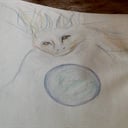As energy moves away from the epicenter of an earthquake, which shows the wave speed from fastest to slowest?
As an earthquake releases the energy of much pressure, the energy is released in several ways through the rock, soil, and water.
Waves that travels the most quickly are p-waves, about 6 km/sec in the upper crust. On a graph, they look roughly like the letter "p" laid on its side strung together with others. If you stand on a rock or the ground floor of a building, they will feel like a person is below you hammering upwards to you.
Next fastest are the s-waves, about 3.5 km/sec in the upper crust. They carry more energy and shake the ground back and forth at right angles to the direction of the wave. They shear the materials, including rocks. In a building you can feel the foundation rocking back and forth as the waves travel through.
Slowest of the three are the surface waves at about 2.5 km/sec. These waves shake the surface of the earth up and down and do the most damage of all of the types of waves. They will cause the surface of the soil to move up and down in wavelike patterns like you would see on the sea in a boat. Observations can include trees, light poles, and trees moving back and forth with large amplitudes of vibration.
Combined, these three types of waves do different types of damage to natural and man-made structures. Maybe a p-wave will knock the bolts out of a wall connection and the surface waves will make the wall fall down. Being as random as they are, earthquakes are difficult events for which to prepare.
More Info:
www.columbia.edu


